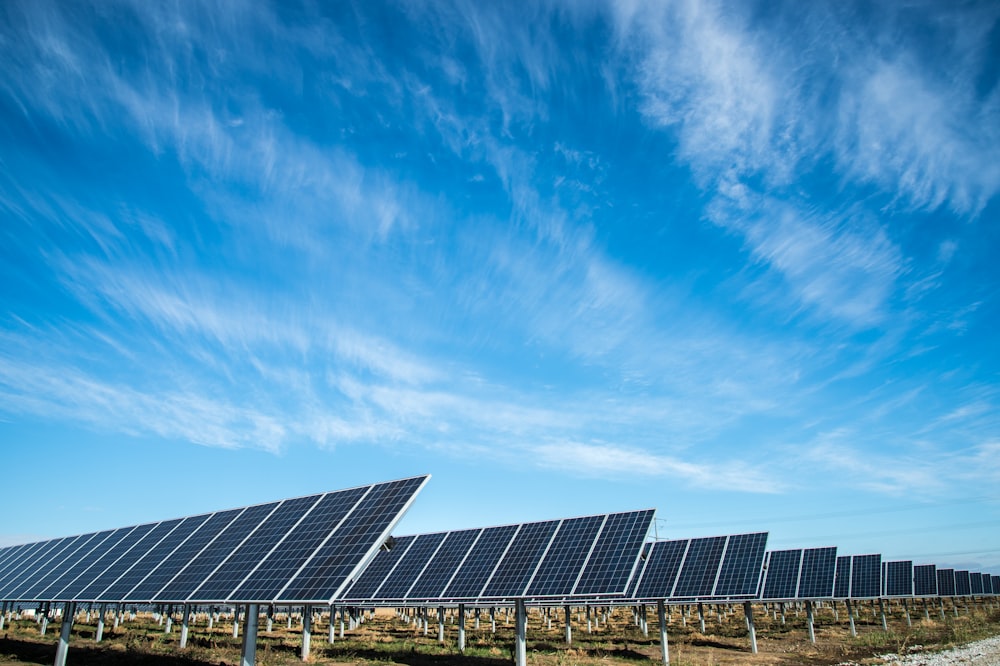 Photo of solar panels
Photo of solar panels
Hello buddies! It’s nice having you back again! Previously on a post where Jeanice talked about Green City in Singapore, she mentioned the implementation of photovoltaic(PV) panels and some of its disadvantages. Like me, have you wondered if PV panels are indeed green?
Apart from the disadvantages that Jeanice has briefly mentioned previously, we also need to consider the environmental impact with regard to air pollution and other forms of pollution.
Firstly the fabrication of solar panels requires corrosive chemicals like hydrofluoric acid and sodium hydroxide (Nunez, 2017). The process that it undergoes not only requires water and electricity to power the solar panel production factories, and also a blast furnace which burns fossil fuel and emits greenhouse gases. From A ChannelNews Asia documentary on Coming Clean About Green where they looked into whether Green Technologies are indeed helping our planet, to produce one clean silicon atom, one carbon atom is required from coal. Though they tried replacing carbon from coal with something more environmentally friendly, they think that carbon is still the best and cheapest thus far. Moreover, there was a study mentioned in the video which found that the carbon emitted from the production of solar panels for energy is lower than that of coal or gas. In other words, current PV panels are already contributing significantly to reducing carbon emissions. Hence, they are definitely a better option in reducing air pollution.
There are also other concerns which include precious resources being wasted if not recycled properly. As PV panels are made of several resources and some are rare materials, it is important to recycle and reuse them and prevent its depletion. Though that is said, it is clear that a PV panel can last around 10 years and there aren’t many available faulty PV panels for us to recycle now. Nevertheless, it is crucial to start planning ahead and adopt sustainable practices early so that we are prepared to recycle those PV panels in years to come, which will greatly reduce the waste and still be economically attractive.
Furthermore, appropriate disposal of PV panels is also highly recommended as some PV panels with thinner films contain toxic chemicals. Thus, if disposed of inappropriately, harmful chemicals might be released into the atmosphere. These chemicals could be bioaccumulative, persistent, and transformable into even toxic chemicals in the environment and may harm our environment and health in the long run.
There is a news that mentioned about a safe recycling process which is adopted by many manufacturers. It can reduce the health and environmental risks by recycling silicon compounds from PV panels back into the manufacturing process to produce new PV panels (Thoubboron, 2019). It is applaudable as companies are making an effort in trying to reduce air pollution through recycling instead of irresponsible disposal which may lead to the release of harmful chemicals into our environment.
However, a study found that the carbon emissions of a PV panel from China double the amount in Europe as there are lesser environmental standards and more coal-powered plants in China (Thoubboron, 2019). This shows that there is room for improvement by some companies and their respective country’s government. Hence, this highlights the pivotal role of the government in regulating the industry to minimize the risk of chemicals used to be leaked into our environment and to limit its emissions to one that is attainable in other countries as well.
We have seen that PV panels have the potential to pollute our environment and it is the responsibility of both the companies and governments to ensure a strict yet attainable environmental standard and abide by it. Not to forget, as consumers, we can also find out more information about the manufacturers to know whether their operation of business is environmentally friendly or not before we go on to purchase from them. With our cooperative efforts and wiser decision-making when supporting greener manufacturers, it will discourage other companies to continue their way of operation which produces huge amounts of emissions. In short, though PV panels use carbon from coal and emit some emissions, it is undeniable and clear that their long term benefit outweighs its emissions, provided that we recycle and reuse it.
Comment below to let me know what’s your stand on this topic! 😊
Your environmental buddy,
Zhi Yong
References:
Nunez, C. (2017, September 19). How Green Are Those Solar Panels, Really? Retrieved from https://www.nationalgeographic.com/news/energy/2014/11/141111-solar-panel-manufacturing-sustainability-ranking/
Thoubboron, K. (2019, November 05). Are Solar Panels Toxic or Bad For the Environment?: EnergySage. Retrieved from https://news.energysage.com/solar-panels-toxic-environment/
